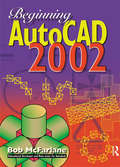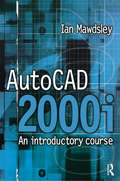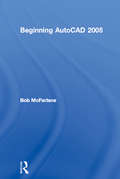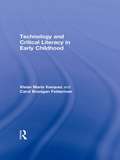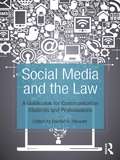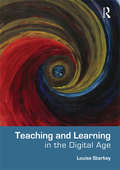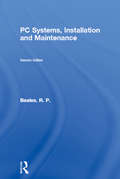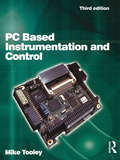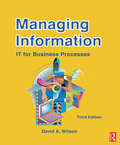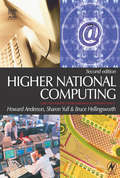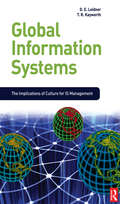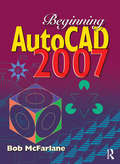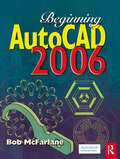- Table View
- List View
Beginning AutoCAD 2002
by Bob McFarlaneNew features in AutoCAD 2002 are covered in this book, making it a useful refresher course for anyone using AutoCAD at this level, and upgrading to the new software release. The material in the book is also relevant to anyone using other recent releases, including, AutoCAD 2000.
AutoCAD 2000i: An Introductory Course
by Ian MawdsleyThe step-by-step instructions and clear explanations make the book ideal for courses with limited contact time, and for independent study. Numerous exercises throughout enable students to develop their own CAD skills as well as reinforcing their understanding of AutoCAD commands.Ian Mawdsley has drawn on his own extensive teaching experience to produce material for use in a CAD suite where the lecturer will be supporting a number of students who are progressing at different rates. His book is the only AutoCAD resource available written with a real understanding of teaching requirements - a breath of fresh air for lecturers who have been working with hefty application manuals or superficial software guides. This book has been carefully designed to meet the needs of AutoCAD courses run by universities, colleges and an increasing number of schools. Anyone who completes Ian Mawdsley's course will have gained a thorough grounding in 2D techniques and explored the basics of 3D work. The content of the course covers the requirements of the new City & Guilds 4351 scheme and the new Edexcel Advanced Award in AutoCAD (level 3).
AutoCAD 2000i: An Introductory Course
by Ian MawdsleyThe step-by-step instructions and clear explanations make the book ideal for courses with limited contact time, and for independent study. Numerous exercises throughout enable students to develop their own CAD skills as well as reinforcing their understanding of AutoCAD commands.Ian Mawdsley has drawn on his own extensive teaching experience to produce material for use in a CAD suite where the lecturer will be supporting a number of students who are progressing at different rates. His book is the only AutoCAD resource available written with a real understanding of teaching requirements - a breath of fresh air for lecturers who have been working with hefty application manuals or superficial software guides. This book has been carefully designed to meet the needs of AutoCAD courses run by universities, colleges and an increasing number of schools. Anyone who completes Ian Mawdsley's course will have gained a thorough grounding in 2D techniques and explored the basics of 3D work. The content of the course covers the requirements of the new City & Guilds 4351 scheme and the new Edexcel Advanced Award in AutoCAD (level 3).
Beginning AutoCAD 2005
by Bob McFarlaneBeginning AutoCAD 2005 is a course based on learning and practising the essentials of 2D drawing using AutoCAD. Bob McFarlane’s hands-on approach is uniquely suited to independent learning and use on courses. The focus on 2D drawing in one book, ensures the reader gets a thorough grounding in the subject, with a greater depth of coverage than tends to be available from general introductions to AutoCAD. As a result, this book provides a true, step-by-step, detailed exploration of the AutoCAD functions required at each stage of producing a 2D drawing – an approach often not found in the many software reference guides available.The emphasis on learning through doing makes this book ideal for anyone involved in engineering, construction or architecture – where the focus is on productivity and practical skills. The author has also matched the coverage to the requirements of City and Guilds, Edexcel (BTEC) and SQA syllabuses.New features in AutoCAD 2005 are covered in this book including: Drafting Tools; Drawing Management; Drawing Output; Plot and Publish Tools; Productivity Tools; Sheet Set Manager, and Tool Palette Enhancements. The result is a useful refresher course for anyone using AutoCAD at this level, and those upgrading to the new software release. The course is also designed to be fully relevant to anyone using other recent releases, including AutoCAD 2004.Bob McFarlane is Curriculum Manager for CAD and New Media at Motherwell College, Scotland, and an Autodesk Educational Developer.
Beginning AutoCAD 2005
by Bob McFarlaneBeginning AutoCAD 2005 is a course based on learning and practising the essentials of 2D drawing using AutoCAD. Bob McFarlane’s hands-on approach is uniquely suited to independent learning and use on courses. The focus on 2D drawing in one book, ensures the reader gets a thorough grounding in the subject, with a greater depth of coverage than tends to be available from general introductions to AutoCAD. As a result, this book provides a true, step-by-step, detailed exploration of the AutoCAD functions required at each stage of producing a 2D drawing – an approach often not found in the many software reference guides available.The emphasis on learning through doing makes this book ideal for anyone involved in engineering, construction or architecture – where the focus is on productivity and practical skills. The author has also matched the coverage to the requirements of City and Guilds, Edexcel (BTEC) and SQA syllabuses.New features in AutoCAD 2005 are covered in this book including: Drafting Tools; Drawing Management; Drawing Output; Plot and Publish Tools; Productivity Tools; Sheet Set Manager, and Tool Palette Enhancements. The result is a useful refresher course for anyone using AutoCAD at this level, and those upgrading to the new software release. The course is also designed to be fully relevant to anyone using other recent releases, including AutoCAD 2004.Bob McFarlane is Curriculum Manager for CAD and New Media at Motherwell College, Scotland, and an Autodesk Educational Developer.
Light and Lens: Photography in the Digital Age
by Robert HirschLight & Lens: Photography in the Digital Age is a groundbreaking introductory book that clearly and concisely provides the instruction and building blocks necessary to create thought-provoking digitally based photographs. It is an adventurous idea book that features numerous classroom-tested assignments and exercises from leading photographic educators to encourage you to critically explore and make images from the photographers' eye, an aesthetic point of view. Acquire a basic foundation for digital photography. Light and Lens covers the fundamental concepts of image-making; how to use today's digital technology to create compelling images; and how to output and preserve images in the digital world.Explore the history, theory and methods of digital image-making. Light and Lens translates the enduring aesthetics of art photography into the digital realm. You'll view, capture and think about images from a new perspective.Increase your ability to analyze, discuss and write about your own work and the images of others.Learn with exercises and assignments by leading digital educators. Innovative techniques will train your eye to make the strongest visual statement.Solve visual problems and overcome image challenges. Whether you use a digital SLR or a point-and-shoot camera, you'll get new strategies to master composition, design and light. View the full range of the digital terrain with stunning images and commentary by over 190 international artists.Robert Hirsch is a renowned photographer, educator, historian and writer. His book credits include Photographic Possibilities: The Expressive Use of Ideas, Materials and Processes; Exploring Color Photography: From the Darkroom to the Digital Studio; and Seizing the Light: A History of Photography. He has had many one-person shows and curated numerous exhibitions. Hirsch has also conducted many workshops and interviewed eminent photographers of our time. The former executive director of CEPA Gallery, he is now the director of Light Research in Buffalo, New York, and on the Visual Studies faculty of University of Buffalo/The State University of New York.
Light and Lens: Photography in the Digital Age
by Robert HirschLight & Lens: Photography in the Digital Age is a groundbreaking introductory book that clearly and concisely provides the instruction and building blocks necessary to create thought-provoking digitally based photographs. It is an adventurous idea book that features numerous classroom-tested assignments and exercises from leading photographic educators to encourage you to critically explore and make images from the photographers' eye, an aesthetic point of view. Acquire a basic foundation for digital photography. Light and Lens covers the fundamental concepts of image-making; how to use today's digital technology to create compelling images; and how to output and preserve images in the digital world.Explore the history, theory and methods of digital image-making. Light and Lens translates the enduring aesthetics of art photography into the digital realm. You'll view, capture and think about images from a new perspective.Increase your ability to analyze, discuss and write about your own work and the images of others.Learn with exercises and assignments by leading digital educators. Innovative techniques will train your eye to make the strongest visual statement.Solve visual problems and overcome image challenges. Whether you use a digital SLR or a point-and-shoot camera, you'll get new strategies to master composition, design and light. View the full range of the digital terrain with stunning images and commentary by over 190 international artists.Robert Hirsch is a renowned photographer, educator, historian and writer. His book credits include Photographic Possibilities: The Expressive Use of Ideas, Materials and Processes; Exploring Color Photography: From the Darkroom to the Digital Studio; and Seizing the Light: A History of Photography. He has had many one-person shows and curated numerous exhibitions. Hirsch has also conducted many workshops and interviewed eminent photographers of our time. The former executive director of CEPA Gallery, he is now the director of Light Research in Buffalo, New York, and on the Visual Studies faculty of University of Buffalo/The State University of New York.
Technology and Critical Literacy in Early Childhood
by Vivian Maria Vasquez Carol Branigan FeldermanWhat do new technologies and new forms of communication mean for young children growing up in the 21st century? How are they shaping the mindsets, identities and practices which impact their lives at home and at school? This book explores the intersection of technology and critical literacy, specifically addressing what ICTs afford critical literacy work with young children between ages three to eight. Inviting readers to enter classrooms where both technology and critical literacies are woven into childhood curricula and teaching, it brings together literacy, social studies, and science in critical and integrated ways. Real-world stories show the sights and sounds of children engaged with technology in the classroom and beyond. Concise but comprehensive, the text provides strategies, theoretical frameworks, demonstrations of practice, and resources for teachers. Pedagogical features in each chapter engage readers in making connections to their own teaching situations. NCATE standards for including technology as an essential part of teacher education programs are addressed. While acknowledging how individual children employ ICT, the focus is on how new technologies can be positioned in early childhood learning communities as tools for engaging in more meaningful, authentic, and interesting learning.
Social Media and the Law: A Guidebook for Communication Students and Professionals
by Daxton R. “Chip” StewartSocial media platforms like Facebook, Twitter, Pinterest, YouTube, and Flickr allow users to connect with one another and share information with the click of a mouse or a tap on a touchscreen—and have become vital tools for professionals in the news and strategic communication fields. But as rapidly as these services have grown in popularity, their legal ramifications aren’t widely understood. To what extent do communicators put themselves at risk for defamation and privacy lawsuits when they use these tools, and what rights do communicators have when other users talk about them on social networks? How can an entity maintain control of intellectual property issues—such as posting copyrighted videos and photographs—consistent with the developing law in this area? How and when can journalists and publicists use these tools to do their jobs without endangering their employers or clients? In Social Media and the Law, eleven media law scholars address these questions and more, including current issues like copyright, online impersonation, anonymity, cyberbullying, sexting, and WikiLeaks. Students and professional communicators alike need to be aware of laws relating to defamation, privacy, intellectual property, and government regulation—and this guidebook is here to help them navigate the tricky legal terrain of social media.
Social Media and the Law: A Guidebook for Communication Students and Professionals
by Daxton StewartSocial media platforms like Facebook, Twitter, Pinterest, YouTube, and Flickr allow users to connect with one another and share information with the click of a mouse or a tap on a touchscreen—and have become vital tools for professionals in the news and strategic communication fields. But as rapidly as these services have grown in popularity, their legal ramifications aren’t widely understood. To what extent do communicators put themselves at risk for defamation and privacy lawsuits when they use these tools, and what rights do communicators have when other users talk about them on social networks? How can an entity maintain control of intellectual property issues—such as posting copyrighted videos and photographs—consistent with the developing law in this area? How and when can journalists and publicists use these tools to do their jobs without endangering their employers or clients? In Social Media and the Law, eleven media law scholars address these questions and more, including current issues like copyright, online impersonation, anonymity, cyberbullying, sexting, and WikiLeaks. Students and professional communicators alike need to be aware of laws relating to defamation, privacy, intellectual property, and government regulation—and this guidebook is here to help them navigate the tricky legal terrain of social media.
Teaching and Learning in the Digital Age
by Louise StarkeyTeaching and Learning in the Digital Age is for all those interested in considering the impact of emerging digital technologies on teaching and learning. It explores the concept of a digital age and perspectives of knowledge, pedagogy and practice within a digital context. By examining teaching with digital technologies through new learning theories cognisant of the digital age, it aims to both advance thinking and offer strategies for teaching technology-savvy students that will enable meaningful learning experiences. Illustrated throughout with case studies from across the subjects and the age range, key issues considered include: how young people create and share knowledge both in and beyond the classroom and how current and new pedagogies can support this level of achievement the use of complexity theory as a framework to explore teaching in the digital age the way learning occurs – one way exchanges, online and face-to-face interactions, learning within a framework of constructivism, and in communities what we mean by critical thinking, why it is important in a digital age, and how this can occur in the context of learning how students can create knowledge through a variety of teaching and learning activities, and how the knowledge being created can be shared, critiqued and evaluated. With an emphasis throughout on what it means for practice, this book aims to improve understanding of how learning theories currently work and can evolve in the future to promote truly effective learning in the digital age. It is essential reading for all teachers, student teachers, school leaders, those engaged in Masters’ Level work, as well as students on Education Studies courses.
Teaching and Learning in the Digital Age
by Louise StarkeyTeaching and Learning in the Digital Age is for all those interested in considering the impact of emerging digital technologies on teaching and learning. It explores the concept of a digital age and perspectives of knowledge, pedagogy and practice within a digital context. By examining teaching with digital technologies through new learning theories cognisant of the digital age, it aims to both advance thinking and offer strategies for teaching technology-savvy students that will enable meaningful learning experiences. Illustrated throughout with case studies from across the subjects and the age range, key issues considered include: how young people create and share knowledge both in and beyond the classroom and how current and new pedagogies can support this level of achievement the use of complexity theory as a framework to explore teaching in the digital age the way learning occurs – one way exchanges, online and face-to-face interactions, learning within a framework of constructivism, and in communities what we mean by critical thinking, why it is important in a digital age, and how this can occur in the context of learning how students can create knowledge through a variety of teaching and learning activities, and how the knowledge being created can be shared, critiqued and evaluated. With an emphasis throughout on what it means for practice, this book aims to improve understanding of how learning theories currently work and can evolve in the future to promote truly effective learning in the digital age. It is essential reading for all teachers, student teachers, school leaders, those engaged in Masters’ Level work, as well as students on Education Studies courses.
PC Systems, Installation and Maintenance
by R. P. BealesWritten in a straightforward, easy to read style, Rob Beales provides the knowledge and techniques needed to build, troubleshoot, and maintain personal computer systems.Divided into three parts, Part 1 forms an introduction to digital computers, leading the reader through the various parts of a modern PC system, including popular peripherals and networking concepts. Part 2 contains a step-by-step guide on the assembly and configuration of a complete state-of-the-art PC system, including a section on the use of important Windows 98 / ME / 2000 / XP applications and components. Part 3 covers preventative, predictive and corrective maintenance, based in typical current work practice – a major part of the IT practitioner’s work schedule.Case Studies and practical worked examples are included throughout the text, with additional Case Studies, specifically aimed to meet the requirements of e-Quals courses on an accompanying website. Further web resources include key figures from the text available to download in full-colour, with a wealth of extra material covering Binary / Hex and basic logic functions; ASCII tables; Connector types and pinouts; Bus slots; RAM slots and further useful website links.Updated throughout in line with current technologies, the second edition is also designed to cover the latest specifications of BTEC National and City and Guilds e-Quals (400 and 500) courses, and the A+ certification, in addition to meeting the needs of the general PC user.
PC Systems, Installation and Maintenance
by R. P. BealesWritten in a straightforward, easy to read style, Rob Beales provides the knowledge and techniques needed to build, troubleshoot, and maintain personal computer systems.Divided into three parts, Part 1 forms an introduction to digital computers, leading the reader through the various parts of a modern PC system, including popular peripherals and networking concepts. Part 2 contains a step-by-step guide on the assembly and configuration of a complete state-of-the-art PC system, including a section on the use of important Windows 98 / ME / 2000 / XP applications and components. Part 3 covers preventative, predictive and corrective maintenance, based in typical current work practice – a major part of the IT practitioner’s work schedule.Case Studies and practical worked examples are included throughout the text, with additional Case Studies, specifically aimed to meet the requirements of e-Quals courses on an accompanying website. Further web resources include key figures from the text available to download in full-colour, with a wealth of extra material covering Binary / Hex and basic logic functions; ASCII tables; Connector types and pinouts; Bus slots; RAM slots and further useful website links.Updated throughout in line with current technologies, the second edition is also designed to cover the latest specifications of BTEC National and City and Guilds e-Quals (400 and 500) courses, and the A+ certification, in addition to meeting the needs of the general PC user.
PC Based Instrumentation and Control
by Mike TooleyPC Based Instrumentation and Control is a guide to implementing computer control, instrumentation and data acquisition using a standard PC and some of the most popular computer languages.Numerous examples of configurations and working circuits, as well as representative software, make this a practical, hands-on guide to implementing PC-based testing and calibration systems and increasing efficiency without compromising quality or reliability. Guidance is given on modifying the circuits and software routines to meet the reader's specific needs.The third edition includes updated coverage of PC hardware and bus systems, a new chapter on virtual instruments and an introduction to programming and software development in a modern 32-bit environment. Additional examples have been included, with source code and executables available for download from the companion website www.key2control.com.
PC Based Instrumentation and Control
by Mike TooleyPC Based Instrumentation and Control is a guide to implementing computer control, instrumentation and data acquisition using a standard PC and some of the most popular computer languages.Numerous examples of configurations and working circuits, as well as representative software, make this a practical, hands-on guide to implementing PC-based testing and calibration systems and increasing efficiency without compromising quality or reliability. Guidance is given on modifying the circuits and software routines to meet the reader's specific needs.The third edition includes updated coverage of PC hardware and bus systems, a new chapter on virtual instruments and an introduction to programming and software development in a modern 32-bit environment. Additional examples have been included, with source code and executables available for download from the companion website www.key2control.com.
Managing Information
by David A Wilson'Managing Information' describes how successful organizations make best use of information and knowledge - the key resources in business. It explains why information technology is essential for the management of business processes, and should be central to any business strategy. This updated edition provides a compelling rationale for organizations to use appropriate systems, and for individuals to acquire the skills to manage and use the systems. It describes how computer systems continue to evolve to meet business needs, and provides examples and exercises to help readers develop their skills. There is a new emphasis on the Internet - how to use it to keep up to date with the latest business issues, and how teams can communicate and collaborate with intranets.All of the most common sub-systems are described and explained, including Enterprise Resource Planning (ERP), Business-to-Business (B2B), Business-to-Consumer (B2C), Supply Chain Management (SCM), Customer Relationship Management (CRM) and Enterprise Application Integration (EAI). The latest developments are described, including services available through the Internet from Application Service Providers (ASP), collaborative commerce and Business Process Management (BPM).There are introductory and more advanced computer exercises to consolidate learning and demonstrate how to acquire, store, organize and present information, using Word, Excel, PowerPoint and Explorer.
Managing Information
by David A Wilson'Managing Information' describes how successful organizations make best use of information and knowledge - the key resources in business. It explains why information technology is essential for the management of business processes, and should be central to any business strategy. This updated edition provides a compelling rationale for organizations to use appropriate systems, and for individuals to acquire the skills to manage and use the systems. It describes how computer systems continue to evolve to meet business needs, and provides examples and exercises to help readers develop their skills. There is a new emphasis on the Internet - how to use it to keep up to date with the latest business issues, and how teams can communicate and collaborate with intranets.All of the most common sub-systems are described and explained, including Enterprise Resource Planning (ERP), Business-to-Business (B2B), Business-to-Consumer (B2C), Supply Chain Management (SCM), Customer Relationship Management (CRM) and Enterprise Application Integration (EAI). The latest developments are described, including services available through the Internet from Application Service Providers (ASP), collaborative commerce and Business Process Management (BPM).There are introductory and more advanced computer exercises to consolidate learning and demonstrate how to acquire, store, organize and present information, using Word, Excel, PowerPoint and Explorer.
Higher National Computing
by Howard Anderson Sharon Yull Bruce HellingsworthHigher National Computing 2e is a new edition of this extremely successful course book, updated specifically to cover the compulsory core units of the 2003 BTEC Higher National Computing schemes. Full coverage is given of the four core units for HNC, the two additional core units required at HND, and the Core Specialist Unit 'Quality Systems', common to both certificate and diploma level.Students following the HNC and HND courses will find this book essential reading, as it covers the core material they will be following through the duration of their course. Knowledge-check questions and activities are included throughout, resulting in a clear and straightforward text which encourages independent study.Like the syllabus itself, this book is ideal for students progressing to HNC / HND from GNVQs, as well as A-Level and BTEC National, with content designed to cover the requirements of students following General Computing, Software Engineering and Business IT courses.
Higher National Computing
by Howard Anderson Sharon Yull Bruce HellingsworthHigher National Computing 2e is a new edition of this extremely successful course book, updated specifically to cover the compulsory core units of the 2003 BTEC Higher National Computing schemes. Full coverage is given of the four core units for HNC, the two additional core units required at HND, and the Core Specialist Unit 'Quality Systems', common to both certificate and diploma level.Students following the HNC and HND courses will find this book essential reading, as it covers the core material they will be following through the duration of their course. Knowledge-check questions and activities are included throughout, resulting in a clear and straightforward text which encourages independent study.Like the syllabus itself, this book is ideal for students progressing to HNC / HND from GNVQs, as well as A-Level and BTEC National, with content designed to cover the requirements of students following General Computing, Software Engineering and Business IT courses.
Global Information Systems
by Dorothy E Leidner Tim KayworthInformation technology has had a major impact on individuals, organizations and society over the past 50 years. There are few organizations that can afford to ignore IT and few individuals who would prefer to be without it. As managerial tasks become more complex, so the nature of the required information systems (IS) changes - from structured, routine support to ad hoc, complex enquiries at the highest levels of management. Global Information Systems aims to present the many complex and inter-related issues associated with culture in the management of information systems. The editors have selected a wide range of contemporary articles from leading experts in North America and Europe that represent a wide variety of different national and cultural environments. They offer valid explanations for, rather than simply pointing out cultural differences in articles that cover a variety of national cultures, including: China, Egypt, Finland, Hong Kong, Hungary, India, Jamaica, Peru South Korea, Kuwait, Mexico, Singapore, Sweden, the United Arab Emirate, the UK, and the US.
Global Information Systems
by Dorothy E Leidner Tim KayworthInformation technology has had a major impact on individuals, organizations and society over the past 50 years. There are few organizations that can afford to ignore IT and few individuals who would prefer to be without it. As managerial tasks become more complex, so the nature of the required information systems (IS) changes - from structured, routine support to ad hoc, complex enquiries at the highest levels of management. Global Information Systems aims to present the many complex and inter-related issues associated with culture in the management of information systems. The editors have selected a wide range of contemporary articles from leading experts in North America and Europe that represent a wide variety of different national and cultural environments. They offer valid explanations for, rather than simply pointing out cultural differences in articles that cover a variety of national cultures, including: China, Egypt, Finland, Hong Kong, Hungary, India, Jamaica, Peru South Korea, Kuwait, Mexico, Singapore, Sweden, the United Arab Emirate, the UK, and the US.
Beginning AutoCAD 2007
by Bob McFarlaneBeginning AutoCAD 2007 is a course based on learning and practising the essentials of 2D drawing using AutoCAD. Bob McFarlane's hands-on approach is uniquely suited to independent learning and use on courses. The focus on 2D drawing in one book ensures the reader gets a thorough grounding in the subject, with a greater depth of coverage than tends to be available from general introductions to AutoCAD. As a result, this book provides a true, step-by-step, detailed exploration of the AutoCAD functions required at each stage of producing a 2D drawing - an approach often not found in the many software reference guides available.The emphasis on learning through doing makes this book ideal for anyone involved in engineering, construction or architecture - where the focus is on productivity and practical skills. The author has also matched the coverage to the requirements of City and Guilds, Edexcel (BTEC) and SQA syllabuses.The following new features in AutoCAD 2007 are covered in this book:* Create: Using enhanced commands and draughting tools to create all types of content* Manage: Using the Sheet Set Manager and Attribute Extraction to manage data and information* Produce: Using dynamic blocks, dynamic input and selection preview to increase productivity* Share: Using e-transmit, publish to the web and PDF files to share informationPlus, a new companion website features AutoCAD files for selected activities for students to work with.The result is a useful refresher course for anyone using AutoCAD at this level, and those upgrading to the new software release. The course is also designed to be fully relevant to anyone using other recent releases, including AutoCAD 2006.ABOUT THE AUTHOR Bob McFarlane has been writing books on AutoCAD for over 10 years.
Beginning AutoCAD 2007
by Bob McFarlaneBeginning AutoCAD 2007 is a course based on learning and practising the essentials of 2D drawing using AutoCAD. Bob McFarlane's hands-on approach is uniquely suited to independent learning and use on courses. The focus on 2D drawing in one book ensures the reader gets a thorough grounding in the subject, with a greater depth of coverage than tends to be available from general introductions to AutoCAD. As a result, this book provides a true, step-by-step, detailed exploration of the AutoCAD functions required at each stage of producing a 2D drawing - an approach often not found in the many software reference guides available.The emphasis on learning through doing makes this book ideal for anyone involved in engineering, construction or architecture - where the focus is on productivity and practical skills. The author has also matched the coverage to the requirements of City and Guilds, Edexcel (BTEC) and SQA syllabuses.The following new features in AutoCAD 2007 are covered in this book:* Create: Using enhanced commands and draughting tools to create all types of content* Manage: Using the Sheet Set Manager and Attribute Extraction to manage data and information* Produce: Using dynamic blocks, dynamic input and selection preview to increase productivity* Share: Using e-transmit, publish to the web and PDF files to share informationPlus, a new companion website features AutoCAD files for selected activities for students to work with.The result is a useful refresher course for anyone using AutoCAD at this level, and those upgrading to the new software release. The course is also designed to be fully relevant to anyone using other recent releases, including AutoCAD 2006.ABOUT THE AUTHOR Bob McFarlane has been writing books on AutoCAD for over 10 years.
Beginning AutoCAD 2006
by Bob McFarlaneBeginning AutoCAD 2006 is a course based on learning and practising the essentials of 2D drawing using AutoCAD. Bob McFarlane’s hands-on approach is uniquely suited to independent learning and use on courses. The focus on 2D drawing in one book ensures the reader gets a thorough grounding in the subject, with a greater depth of coverage than tends to be available from general introductions to AutoCAD. As a result, this book provides a true, step-by-step, detailed exploration of the AutoCAD functions required at each stage of producing a 2D drawing – an approach often not found in the many software reference guides available.The emphasis on learning through doing makes this book ideal for anyone involved in engineering, construction or architecture – where the focus is on productivity and practical skills. The author has also matched the coverage to the requirements of City and Guilds, Edexcel (BTEC) and SQA syllabuses.New features in AutoCAD 2006 are covered in this book including: DYN (dynamic input showing coordinate position and lengths – an important new feature of the latest AutoCAD software), as well as new commands in the Modify and Dimension tool set. The result is a useful refresher course for anyone using AutoCAD at this level, and those upgrading to the new software release. The course is also designed to be fully relevant to anyone using other recent releases, including AutoCAD 2005.
